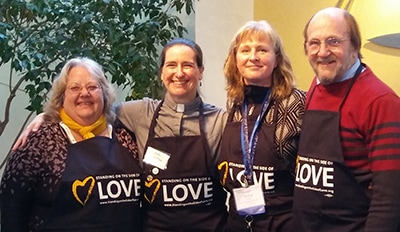Leadership

One of the religious leader's jobs is to show the congregation ways to connect with each other and with the wider community. Religious communities in general and Unitarian Universalist congregations especially exist to encourage the spiritual growth of members and the improvement of the wider world. Helping members uncover their gifts, including gifts for leadership, is an important component in achieving the purposes of religious community.
As a minister, I point out the spiritual and educational aspects of lay ministries within the church. I encourage and equip leaders to reflect on what’s going on within their ministry area on many levels - interpersonal, religious, and task-oriented. Leaders come in all shapes and sizes; I encourage leadership among children and youth as well as adults.
I am a collaborative team leader. I consult with stakeholders, consider the best practices known to our Association, and maintain clarity about my responsibility and authority. As Dan Hotchkiss describes in Governance and Ministry, I support a model in which the senior minister holds the central leadership role in the implementation of the congregation’s ministry and has an advising role with the Board on governance. I encourage committees, task forces, and ministry teams to be explicit about each member's role, and to think about how those roles can be rotated regularly.
I would expect to operate as the chief of staff, responsible for encouraging the professional development and team collaboration of program and administrative staff members. My style as a supervisor is to emphasize each staff member’s strengths and giftedness for ministry, while maintaining clarity about concrete goals and the essential tasks of each role. Effective working relationships on the staff team are important and require time and attention from the chief of staff. Together, the senior minister, staff, and lay leaders discern the balance between decisive action and consultative decision-making.
As a minister, I point out the spiritual and educational aspects of lay ministries within the church. I encourage and equip leaders to reflect on what’s going on within their ministry area on many levels - interpersonal, religious, and task-oriented. Leaders come in all shapes and sizes; I encourage leadership among children and youth as well as adults.
I am a collaborative team leader. I consult with stakeholders, consider the best practices known to our Association, and maintain clarity about my responsibility and authority. As Dan Hotchkiss describes in Governance and Ministry, I support a model in which the senior minister holds the central leadership role in the implementation of the congregation’s ministry and has an advising role with the Board on governance. I encourage committees, task forces, and ministry teams to be explicit about each member's role, and to think about how those roles can be rotated regularly.
I would expect to operate as the chief of staff, responsible for encouraging the professional development and team collaboration of program and administrative staff members. My style as a supervisor is to emphasize each staff member’s strengths and giftedness for ministry, while maintaining clarity about concrete goals and the essential tasks of each role. Effective working relationships on the staff team are important and require time and attention from the chief of staff. Together, the senior minister, staff, and lay leaders discern the balance between decisive action and consultative decision-making.